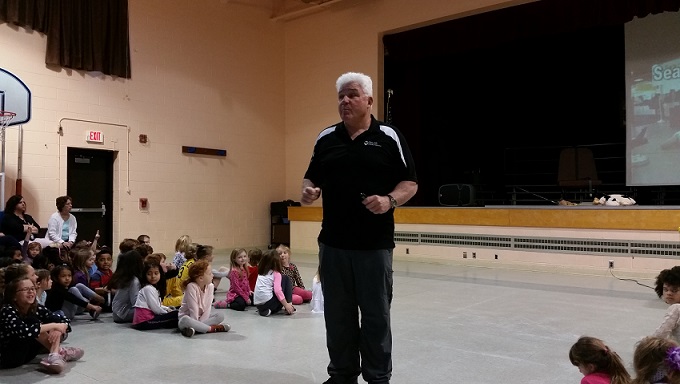 Children listened while Shelton spoke of tips for being safer on the road.
Wayne Shelton looked out on the sea of attentive, young faces Wednesday morning and posed a blunt question that children of this age would normally not have to contemplate.
While stressing the dangers of highway travel, Shelton asked them what happens sometimes when cars are on the road.
"Crash," came the thunderous, collective response from the 380 kindergarten, first, second, and third grade students who filled the multi-purpose room at the Ocean City Primary School.
Shelton shook his head yes, realizing that the children were learning a valuable, potentially lifesaving lesson that should stick with them for many, many years.
Shelton, a traffic safety specialist for the South Jersey Transportation Planning Organization, was at the school for a "Belts on Bones" program that teaches children just how critical it is for them to buckle up.
The "Belts on Bones" moniker refers to the importance of placing seat belts and safety harnesses over the strongest parts of the body for maximum protection.
"People don't usually realize that if safety restraints aren't properly fitted, they can hurt you," Shelton said.
Children listened while Shelton spoke of tips for being safer on the road.
Wayne Shelton looked out on the sea of attentive, young faces Wednesday morning and posed a blunt question that children of this age would normally not have to contemplate.
While stressing the dangers of highway travel, Shelton asked them what happens sometimes when cars are on the road.
"Crash," came the thunderous, collective response from the 380 kindergarten, first, second, and third grade students who filled the multi-purpose room at the Ocean City Primary School.
Shelton shook his head yes, realizing that the children were learning a valuable, potentially lifesaving lesson that should stick with them for many, many years.
Shelton, a traffic safety specialist for the South Jersey Transportation Planning Organization, was at the school for a "Belts on Bones" program that teaches children just how critical it is for them to buckle up.
The "Belts on Bones" moniker refers to the importance of placing seat belts and safety harnesses over the strongest parts of the body for maximum protection.
"People don't usually realize that if safety restraints aren't properly fitted, they can hurt you," Shelton said.
 Nearly 400 children in kindergarten, first, second and third grades at the Ocean City Primary School learned about highway safety Wednesday
The hope is that the children will take the information home and share it with their parents so that the entire family will be safer on the road. In effect, the kids will be teaching the adults.
"We hope this is ingrained in them and will carry forward with good safety practices," said Joel Dougan, the school's guidance counselor who organizes the program every year.
Sgt. Brian Hopely, of the Ocean City Police Department's Traffic Safety Unit, stressed that children are never too young to learn about safety.
"Anything we can do to reinforce safety, especially when they're at this age, will lead to lifelong safety habits," Hopely said.
Studies show that people who receive safety instruction at a young age tend to be more safety conscious when they become drivers and even while riding their bikes, Hopely explained.
Nearly 400 children in kindergarten, first, second and third grades at the Ocean City Primary School learned about highway safety Wednesday
The hope is that the children will take the information home and share it with their parents so that the entire family will be safer on the road. In effect, the kids will be teaching the adults.
"We hope this is ingrained in them and will carry forward with good safety practices," said Joel Dougan, the school's guidance counselor who organizes the program every year.
Sgt. Brian Hopely, of the Ocean City Police Department's Traffic Safety Unit, stressed that children are never too young to learn about safety.
"Anything we can do to reinforce safety, especially when they're at this age, will lead to lifelong safety habits," Hopely said.
Studies show that people who receive safety instruction at a young age tend to be more safety conscious when they become drivers and even while riding their bikes, Hopely explained. Wayne Shelton, of the South Jersey Transportation Planning Organization, demonstrated the proper way to wear safety harnesses on kindergarten student Karissa Kelly.
Karissa, 5, said she learned a lot from the program and would feel "really safe" the next time she rides in a car because she now knows how to protect herself better.
Griffin Gray, 6, a first grader, said he will be sure to tell his family about the safety tips that were discussed during the program.
"I learned about being much safer when I'm in the car, Griffin said.
Some sobering statistics contained in a New Jersey Division of Highway Traffic Safety pamphlet that Shelton handed out illustrate just how dangerous road travel can be for children.
In the United States, motor vehicle crashes are the main cause of death for children over the age of six months, according to the pamphlet.
By Donald Wittkowski
Wayne Shelton, of the South Jersey Transportation Planning Organization, demonstrated the proper way to wear safety harnesses on kindergarten student Karissa Kelly.
Karissa, 5, said she learned a lot from the program and would feel "really safe" the next time she rides in a car because she now knows how to protect herself better.
Griffin Gray, 6, a first grader, said he will be sure to tell his family about the safety tips that were discussed during the program.
"I learned about being much safer when I'm in the car, Griffin said.
Some sobering statistics contained in a New Jersey Division of Highway Traffic Safety pamphlet that Shelton handed out illustrate just how dangerous road travel can be for children.
In the United States, motor vehicle crashes are the main cause of death for children over the age of six months, according to the pamphlet.
By Donald Wittkowski